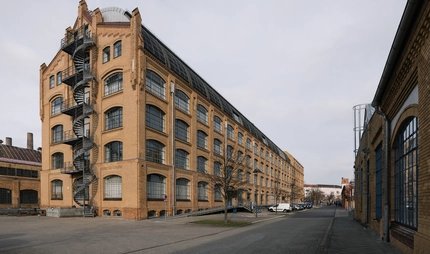
Flughafen Tempelhof (Tempelhof Airport)
From airfield to open space
British architect Norman Foster called it the “mother of all airports”. Tempelhof has lost none of its attraction to this day.
Tempelhofer Feld was an aviation location early on. This is where the American aviation pioneer Orville Wright demonstrated his skills in 1909, and spectators marvelled at the new Zeppelin airships.
Due to a substantial increase in motorised aircraft after the First World War, there was an increased need for a centrally located airport. The first buildings that were constructed quickly proved to be too small. Berlin was a thriving metropolis with a growing number of air passengers.
Modern and monumental
Between 1936 and 1939, architect Ernst Sagebiel designed what would be the biggest airport in Europe at that time on the Tempelhofer Feld: an elegantly curved new building of over 1.2 kilometres in length with 9,000 rooms. It was one of the few Nazi building projects that came to fruition, albeit not completely, and demonstrated the ambivalence between modern construction methods and monumental architecture during the Nazi era.
The exaggerated monumental architecture of the airport building aimed to impress with its natural stone façade. The reception building is characterised by an ornate façade with 21 entrance doors, reliefs, and sculptures such as the giant aluminium eagle, whose head still stands in front of the building to this day. The doors don’t take visitors straight to the entrance hall, but to a hall of honour, which was also to be given an elaborate design.
However, hidden behind the façade with shell limestone slabs and window surrounds made of Jura limestone is a modern construction. During the Weimar Republic, Ernst Sagebiel worked for the architect Erich Mendelsohn. When Mendelsohn had to flee Germany after the Nazis took power, Sagebiel made a career out of modern building techniques.
Sagebiel erected Tempelhof on a steel skeleton construction, which observers can clearly see from the airfield. Despite its monumentality, the airport has a functional design: the architect systematically divided the procedures according to air passengers, baggage, cargo, and mail. This enabled passengers to quickly get from the check-in area to the gate. And the 40-metre, unsupported steel canopy is a technical masterpiece.
However, Hitler's “World Airport” was never completed. Preparations for the war impeded its completion. The rooftop grandstands, where tens of thousands of people were supposed to watch air shows, were never erected. To this day, 13 stairwells remain in an unfinished state – and the air traffic was handled by the old airport from the 1920s. On the new premises, forced labourers were used to produce armaments for the war machine.
The allied aircraft repeatedly attacked Tempelhof and damaged the airport. The Red Army occupied the premises at the end of the war and shortly afterwards it was handed over to the Americans.
Airlift around the clock
With the end of the Second World War, the differences between the superpowers evolved into the cold war. The first high point was the Berlin Blockade.
When the USA also allowed the introduction of the D-Mark in West Berlin, the Soviet Union responded by blockading part of the city on 24 June 1948. Two million inhabitants and the allied occupying forces were suddenly cut off without adequate supplies.

But the USA didn’t give up on West Berlin. On 26 June 1948, the first aircraft already landed in Tempelhof with relief supplies. For eleven months the Allies sent supplies to West Berlin via an airlift. Planes carrying food, medicine, and heating material landed in Tempelhof almost every two minutes around the clock.
The pilots repeatedly brought sweets with them. The American pilot Gail Halvorsen is said to have started a special tradition: he made small parachutes, tied them to the sweets and threw them to the waiting children after landing. As a result, the American aircraft came to be known as Candy Bombers.
On 12 May 1949, the Soviet Union lifted the Berlin Blockade due to the lack of success and Tempelhof Airport became an international symbol of the free West.
West Berlin's gateway to the world
It was only in divided Berlin that Tempelhof Airport fulfilled its real task. When the USA opened it to civil air transport in 1951, it became Germany's biggest airport for several years. The war damage was repaired, extensions were added – and Tempelhof was completed in 1962.
The aeroplane provided the only secure connection between the Federal Republic of Germany and West Berlin, which gave Tempelhof a particular importance. But above all, the international airport of the island city brought glamour: in the 1960s, film stars, athletes, and celebrities presented themselves on the gangways and directors such as Billy Wilder used it as a film set (“One, Two, Three”).
In 1970, the airport was given a new terminal building and in the following year, six million passengers used it for the first time.
Minor role and new ways

However, political and technical developments brought this era to an end. Not only did the 1972 Basis of Relations Treaty between the GDR and the Federal Republic of Germany make it possible to travel across the GDR by car or train on a transit route, but jet planes became an accepted means of air transportation. However, the Tempelhof airfield was too small to accommodate them so West Berlin had to rely on the new airport in Tegel and the airlines relocated. By 1975, Tempelhof was only being used by the United States Air Force.
In 1982, the air force of the USA built the distinctive radar tower with its geodesic dome on four legs. Smaller civil aircraft gradually started flying to Tempelhof again, especially after the German reunification. In 2008, the airport closed its doors for the last time.
Today, the airport building serves as a venue for major events and trade fairs. In a referendum in 2014, Berliners rejected the plan to build on the airfield, preferring instead to use the Tempelhofer Feld as a huge inner-city park.
Tickets for guided tours
To mark the 100th anniversary of the Bauhaus in 2019, the Bauhaus Association developed a Grand Tour of Modernism that takes architecture fans all over Germany. Tempelhof Airport is part of this themed route.
tickets for Grand Tour of Berlin Modernism
Learn more about the airport's past and its use during the National Socialist era in bunkers and shelters.
Tickets for individual city tours
Our tip for Tempelhof Airport
Guided tours through the former Tempelhof Airport building will show you the most important areas of the airport and provide you with information on the history, architecture, and future of the complex.
Practical information from visitBerlin
You can get to the airport by either taking the U-Bahn line 6 to the Platz der Luftbrücke or Paradestrasse stations or the circular line (S-Bahn, Tempelhof station). To explore the city by public transport, we recommend the Berlin Welcome Card.























